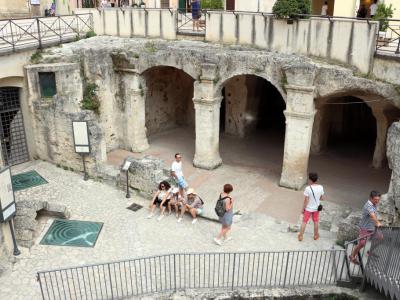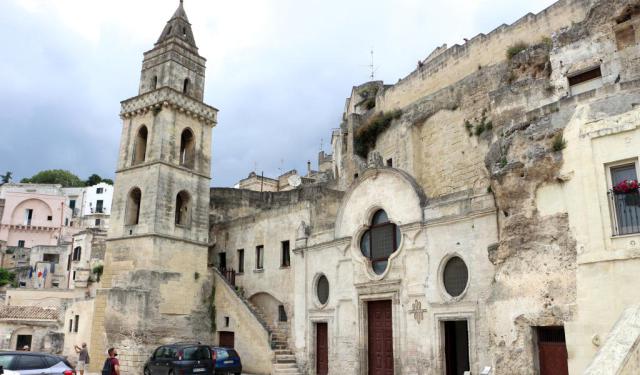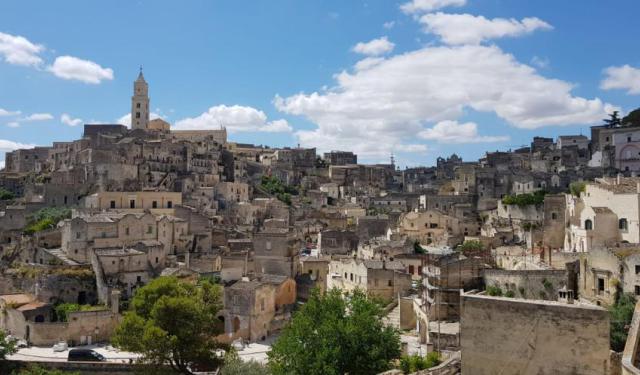
Palombaro Lungo (Palombaro Lungo Cistern), Matera (must see)
Palombaro Lungo Cistern is more than a ordinary cistern. It has been called an underground "Water Cathedral." Located under the Vittorio Veneto Square, the Palombaro Lungo ("Long Diver") holds five million liters of rainwater and water from springs on the surrounding hills of La Nera, Lapillo, and Macamarda. The cistern is always filled. There are boat tours that explain to the visitors the history and functioning of the Palombaro Lungo.
The name "Palombaro" is thought to derive from the Latin word for a raptor that dives on its prey. It could also be from the Latin word "plumbarius," meaning water collector. "Lungo" means "long," a reference to the sheer size of the structure.
Pre-existing water caves were connected into a system to serve a burgeoning population in the 16th century. Because of the presence of people living in those caves, the Palombaro Lungo cistern was not completed until 1882. After being used for over a century, this system was abandoned in 1920 when the Apulian Aqueduct was built.
The "Diver" was rediscovered in 1991 by a group of students led by technical designer Enzo Viti. Enzo, an expert on the underground world of Matera, crossed through the cistern in a dinghy. His voyage underground made the Stones of Matera a UNESCO World Heritage site.
Visitors travel through the entire labyrinthian cistern, immersed in the atmosphere of a vast underground cathedral. The pillars, arches, apses, walls, soaring galleries, and dark, deep waters create an unforgettable experience.
The name "Palombaro" is thought to derive from the Latin word for a raptor that dives on its prey. It could also be from the Latin word "plumbarius," meaning water collector. "Lungo" means "long," a reference to the sheer size of the structure.
Pre-existing water caves were connected into a system to serve a burgeoning population in the 16th century. Because of the presence of people living in those caves, the Palombaro Lungo cistern was not completed until 1882. After being used for over a century, this system was abandoned in 1920 when the Apulian Aqueduct was built.
The "Diver" was rediscovered in 1991 by a group of students led by technical designer Enzo Viti. Enzo, an expert on the underground world of Matera, crossed through the cistern in a dinghy. His voyage underground made the Stones of Matera a UNESCO World Heritage site.
Visitors travel through the entire labyrinthian cistern, immersed in the atmosphere of a vast underground cathedral. The pillars, arches, apses, walls, soaring galleries, and dark, deep waters create an unforgettable experience.
Want to visit this sight? Check out these Self-Guided Walking Tours in Matera. Alternatively, you can download the mobile app "GPSmyCity: Walks in 1K+ Cities" from Apple App Store or Google Play Store. The app turns your mobile device to a personal tour guide and it works offline, so no data plan is needed when traveling abroad.
Palombaro Lungo (Palombaro Lungo Cistern) on Map
Sight Name: Palombaro Lungo (Palombaro Lungo Cistern)
Sight Location: Matera, Italy (See walking tours in Matera)
Sight Type: Attraction/Landmark
Guide(s) Containing This Sight:
Sight Location: Matera, Italy (See walking tours in Matera)
Sight Type: Attraction/Landmark
Guide(s) Containing This Sight:
Walking Tours in Matera, Italy
Create Your Own Walk in Matera
Creating your own self-guided walk in Matera is easy and fun. Choose the city attractions that you want to see and a walk route map will be created just for you. You can even set your hotel as the start point of the walk.
Matera's Ancient Cave Churches
Within the old city of Matera, there are more than 160 churches. Many of these are actually carved into the soft limestone cliffs lining the Gravina River. There are even some used for pagan rituals. The churches were carved from existing caves and tunnels. More than a few sanctified cave churches have been converted to storage and homes.
A good example to start with is the St. Anthony... view more
Tour Duration: 1 Hour(s)
Travel Distance: 1.7 Km or 1.1 Miles
A good example to start with is the St. Anthony... view more
Tour Duration: 1 Hour(s)
Travel Distance: 1.7 Km or 1.1 Miles
Matera Introduction Walking Tour
Architectural historian Anne Parmly Toxey said the cave areas of Matera had been occupied for at least 3,000 years. There have been settlements in Matera since the Paleolithic era.
The town itself was founded in 251 BC by Roman consul Lucius Caecilius Metellus. He called it Matheola. Subsequently, the town was occupied by Longobards, Byzantines, Saracens, Swabians, Angevins, Aragonese, and... view more
Tour Duration: 2 Hour(s)
Travel Distance: 2.4 Km or 1.5 Miles
The town itself was founded in 251 BC by Roman consul Lucius Caecilius Metellus. He called it Matheola. Subsequently, the town was occupied by Longobards, Byzantines, Saracens, Swabians, Angevins, Aragonese, and... view more
Tour Duration: 2 Hour(s)
Travel Distance: 2.4 Km or 1.5 Miles


